Nonlinear vibration of nonlocal strain gradient nanotubes under longitudinal magnetic field
First discovered in 1991 by Iijima [1], carbon nanotubes (CNTs) show many advantages compared to conventional steel tubes. With theirs advantages and small sizes,
CNTs have many applications such as nanoactuator [2], nano-electromechanical systems
(NEMS) [3, 4], nano-devices for electronics [5, 6], nano-medicine [7], or nano-devices for
conveying fluid and gas storage [8,9].
Researching the mechanical behavior of CNTs is an extremely important problem
and attracts many interested scientists. Unlike macro-sized tubes, the size-dependent effect plays an important role in the response of CNTs. Some elasticity theories have been
proposed to study the size-dependent effect on the mechanical response of micro-/nanostructures such as Eringen’s nonlocal elasticity theory [10,11], the strain gradient theory
(SGT) [12, 13], and the modified couple stress theory (MCST) [14]. To date, many works
related to the static and dynamic responses of CNTs have been published using these
higher-order elasticity theories. Nonlinear free vibration responses of the single-walled
carbon nanotubes (SWCNTs) were reported by Yang et al. [15] using the Timoshenko
beam theory and Eringen’s nonlocal elasticity theory. The effects of nonlocal parameter,
length and radius of the SWCNTs with different boundary conditions on the nonlinear
free vibration behaviors of SWCNTs were examined in this work. Narendar et al. [16]
studied the wave propagation problem in the SWCNTs under longitudinal magnetic field
based on Eringen’s nonlocal elasticity theory and the Euler-Bernoulli beam theory. The
wave method was employed by Zhang et al. [17] to analyze the nonlinear free vibration of
the fluid-conveying SWCNTs based on Eringen’s nonlocal elasticity theory. Based on the
Euler-Bernoulli beam theory and Eringen’s nonlocal elasticity theory, Wang and Li [18]
investigated the nonlinear free vibration of the SWCNTs with the viscous damping effect.
Zhen and Fang [19] used the Lindstedt–Poincare method to investigate the nonlinear vi- ´
bration of the fluid-conveying SWCTNs under harmonic excitation. Nonlinear vibration
of the embedded SWCNTs was reported by Valipour et al. [20] using Eringen’s nonlocal
elasticity theory and the parameterized perturbation method. Goughari et al. [21] studied effects of magnetic-fluid flow on the instability of the fluid-conveying SWCNTs under
the magnetic field. Free vibration of the SWCNTs resting on the exponentially varying
elastic foundation was examined by Chakraverty and Jena using Eringen’s nonlocal elasticity theory [2]. Based on the MCST and the Euler-Bernoulli beam theory, Wang [22]
investigated the size-dependent vibration responses of the fluid-conveying microtubes.
Flexural size-dependent vibrations of the microtubes conveying fluid was carried out by
Wang et al. [23] utilizing the MCST. Based on the MCST, Tang et al. [24] developed a nonlinear model to study the size-dependent vibration of the curved microtubes conveying
fluid. Xia and Wang [25] studied vibration and stability behaviors of the microscale pipes
conveying fluid based on Timoshenko beam theory and the MCST. Based on the second
SGT, vibration and stability behaviors of the SWCNTs conveying fluid were presented by
Ghazavi et al. [26].
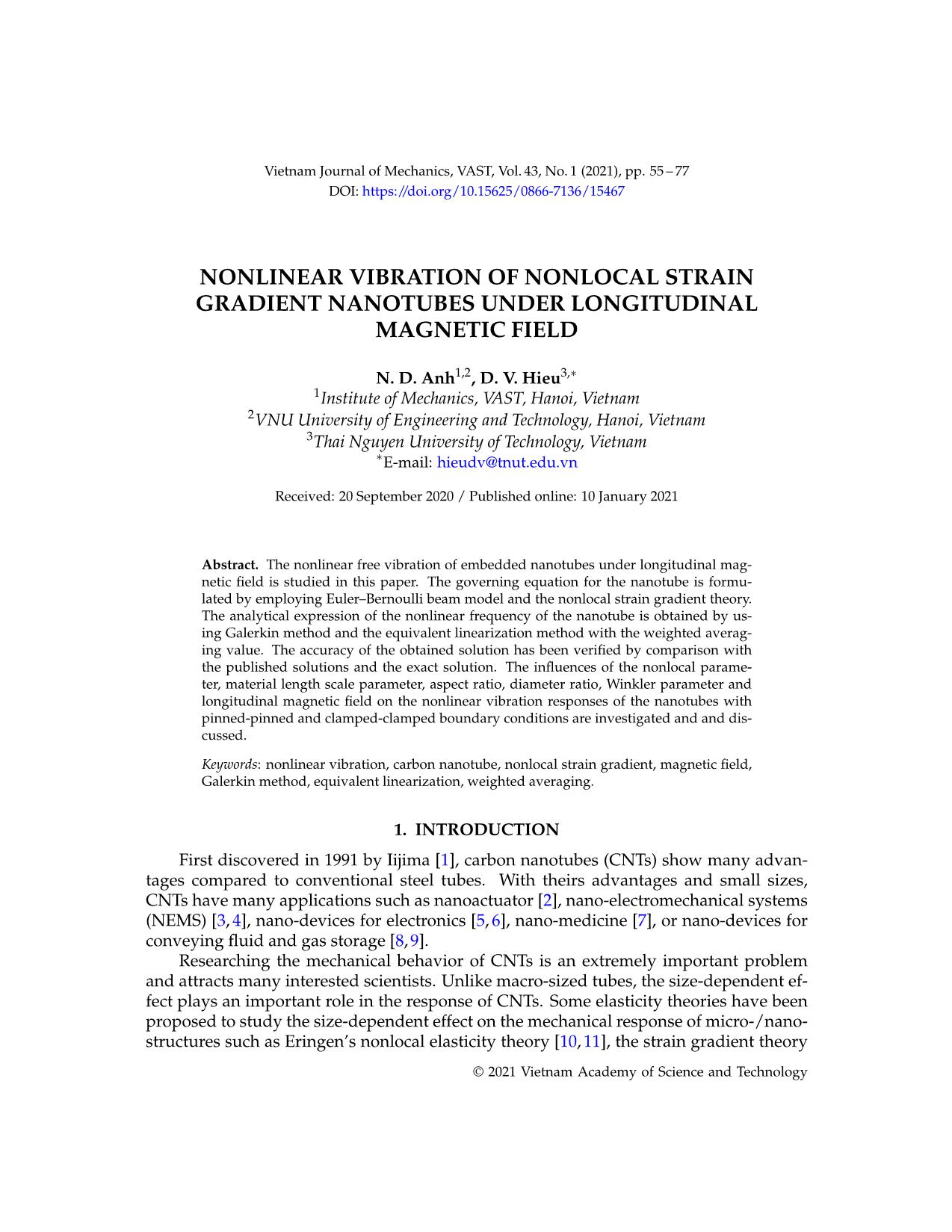
Trang 1
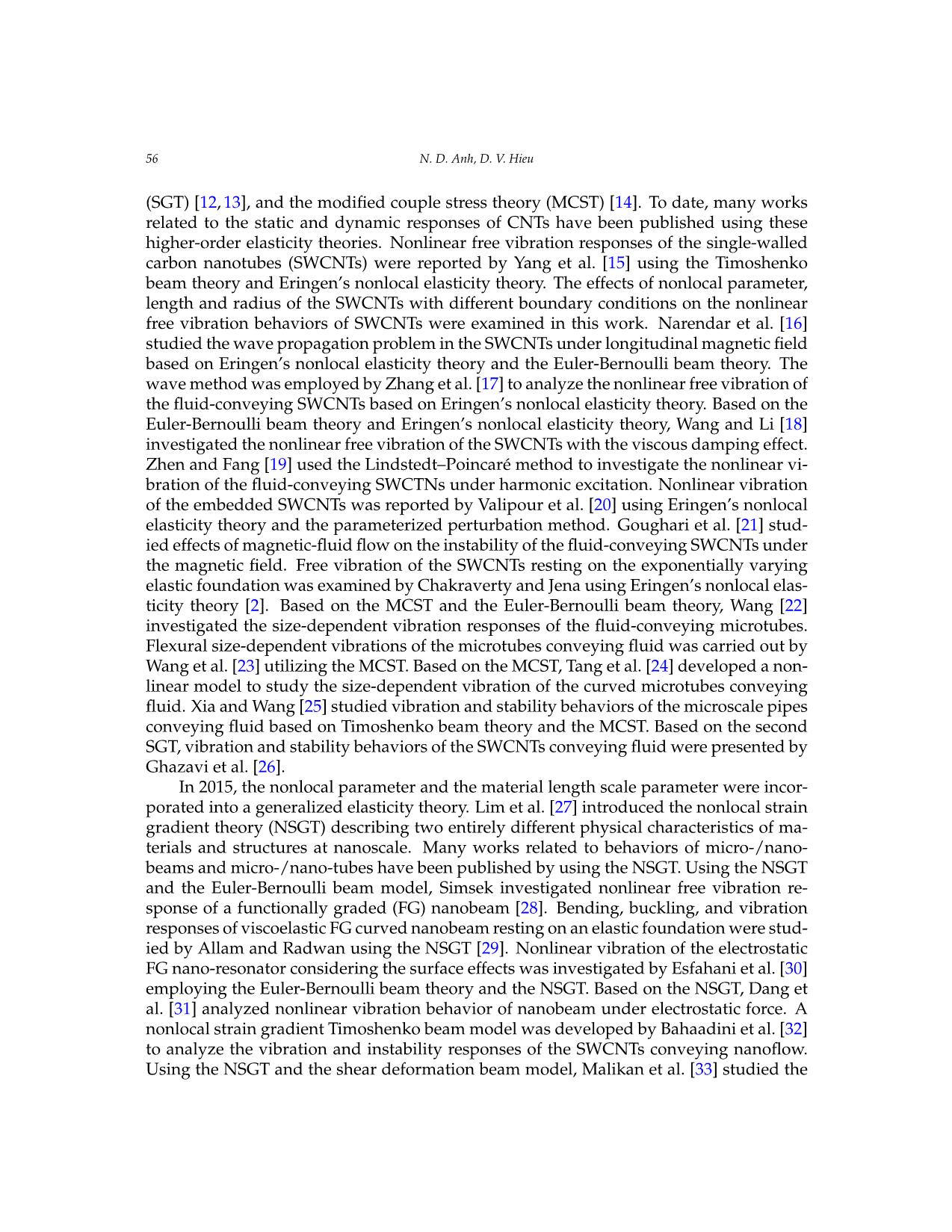
Trang 2
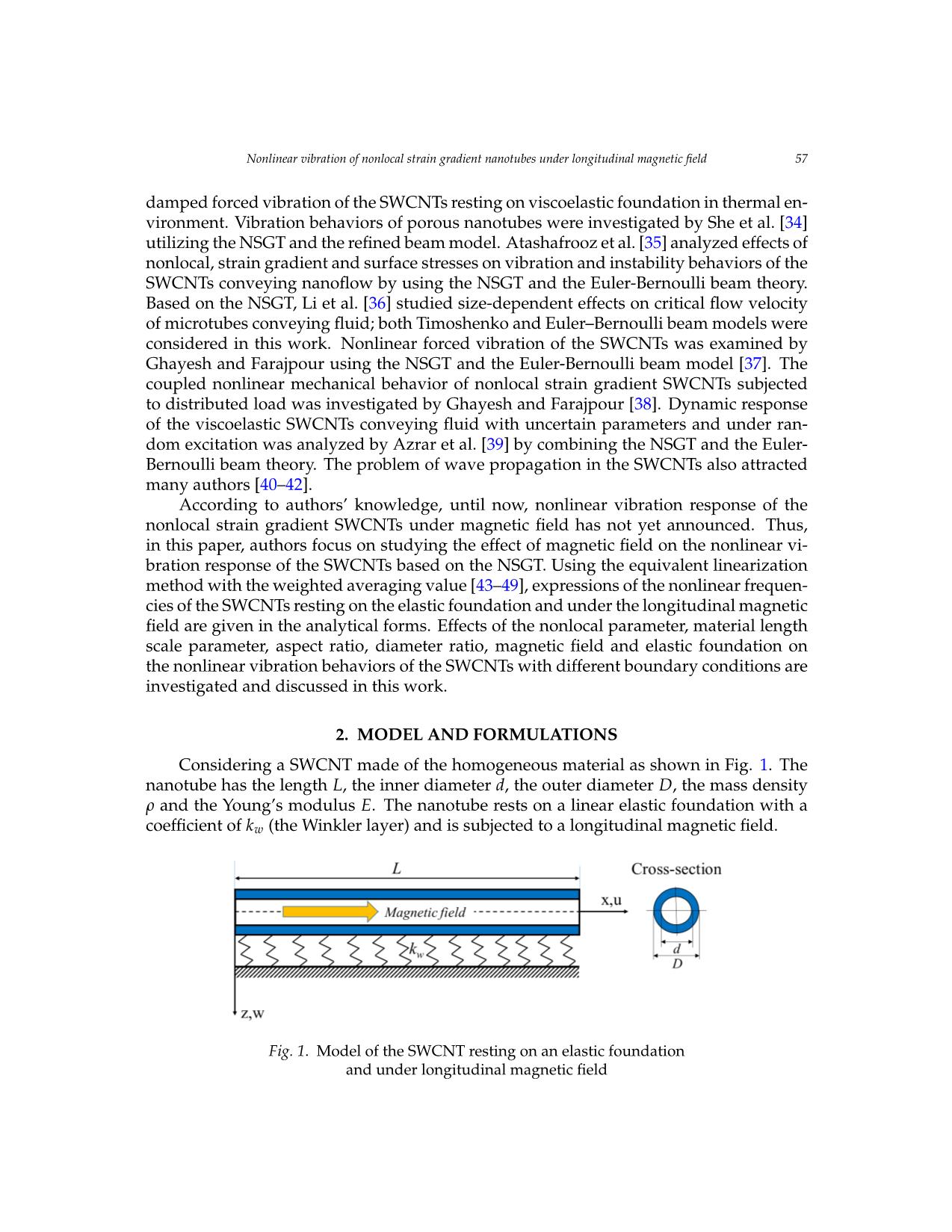
Trang 3
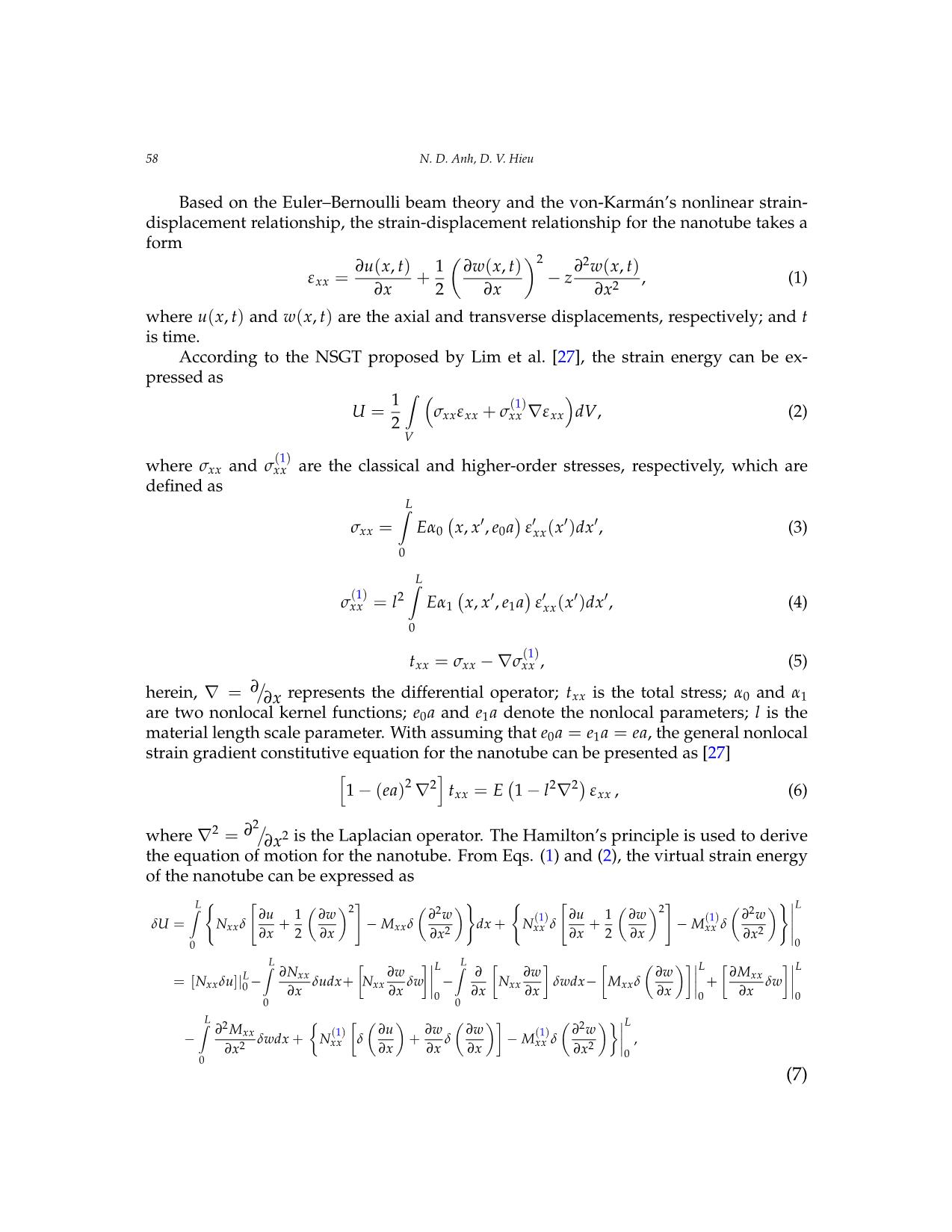
Trang 4
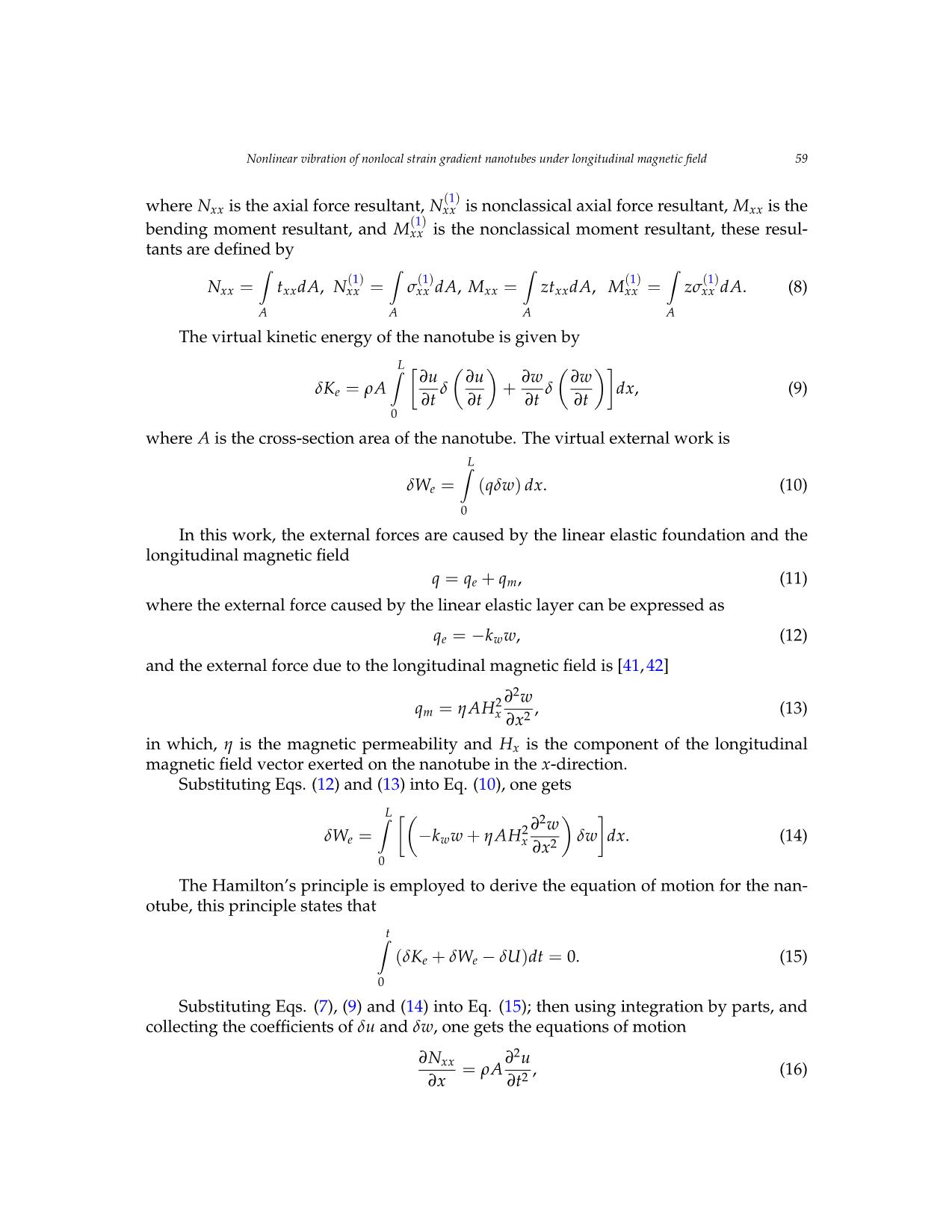
Trang 5
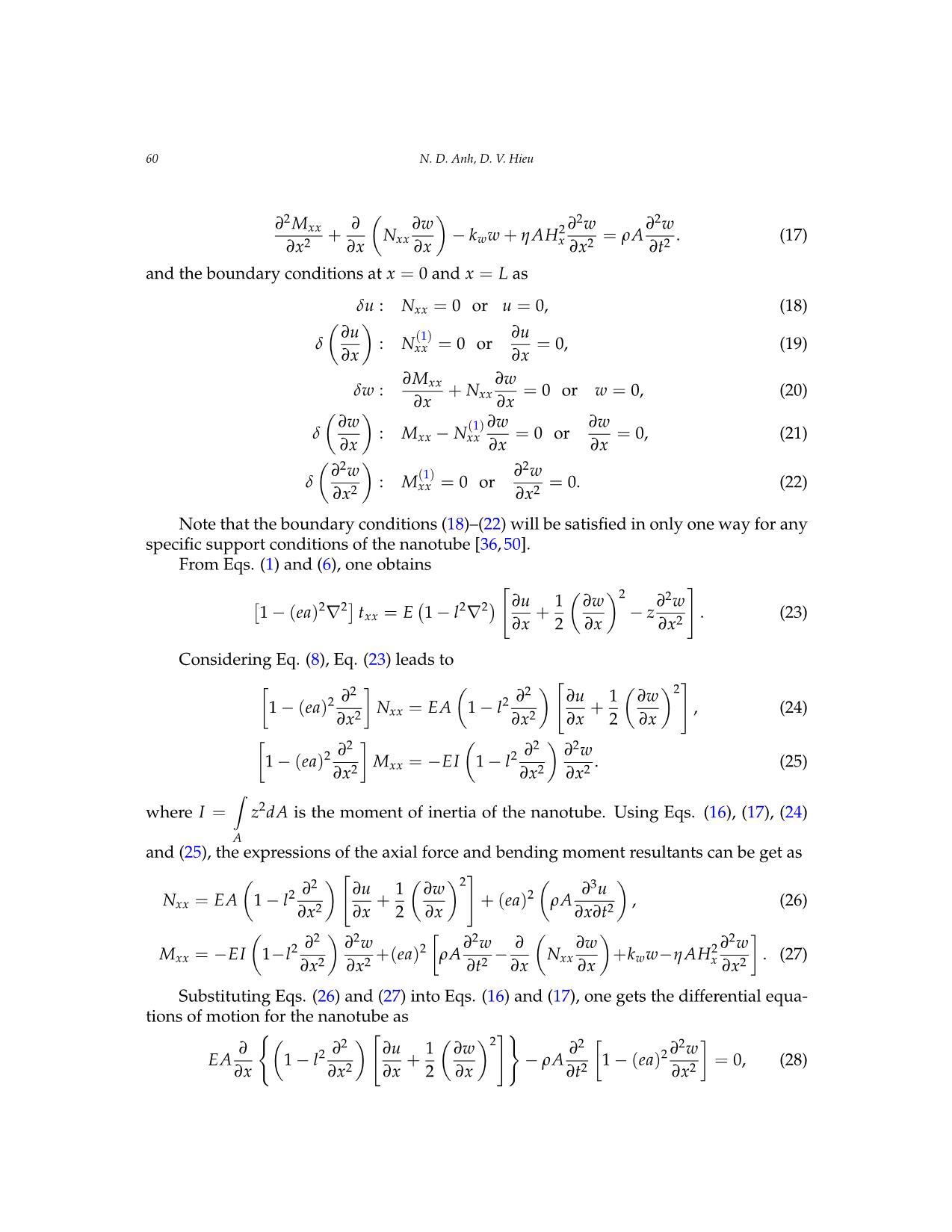
Trang 6
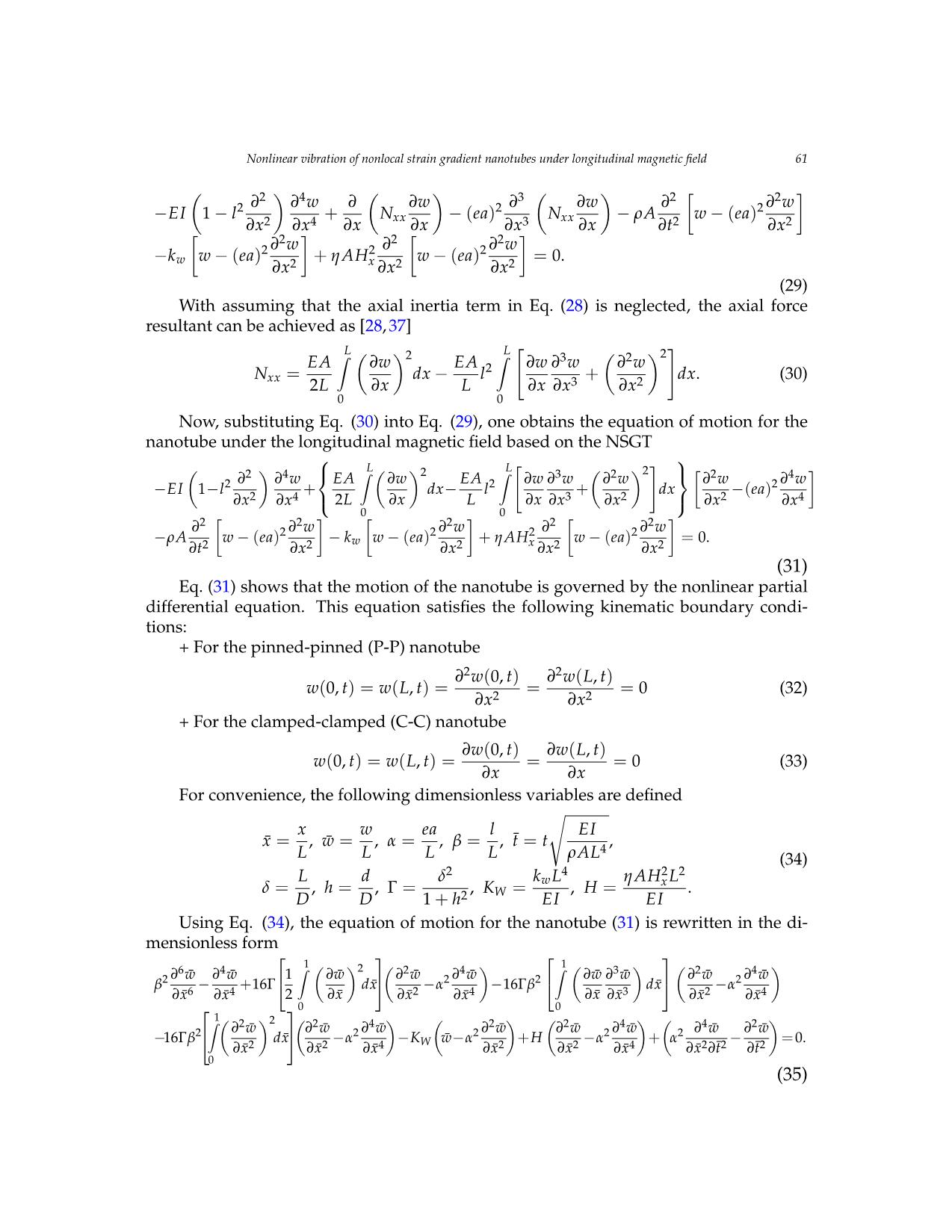
Trang 7
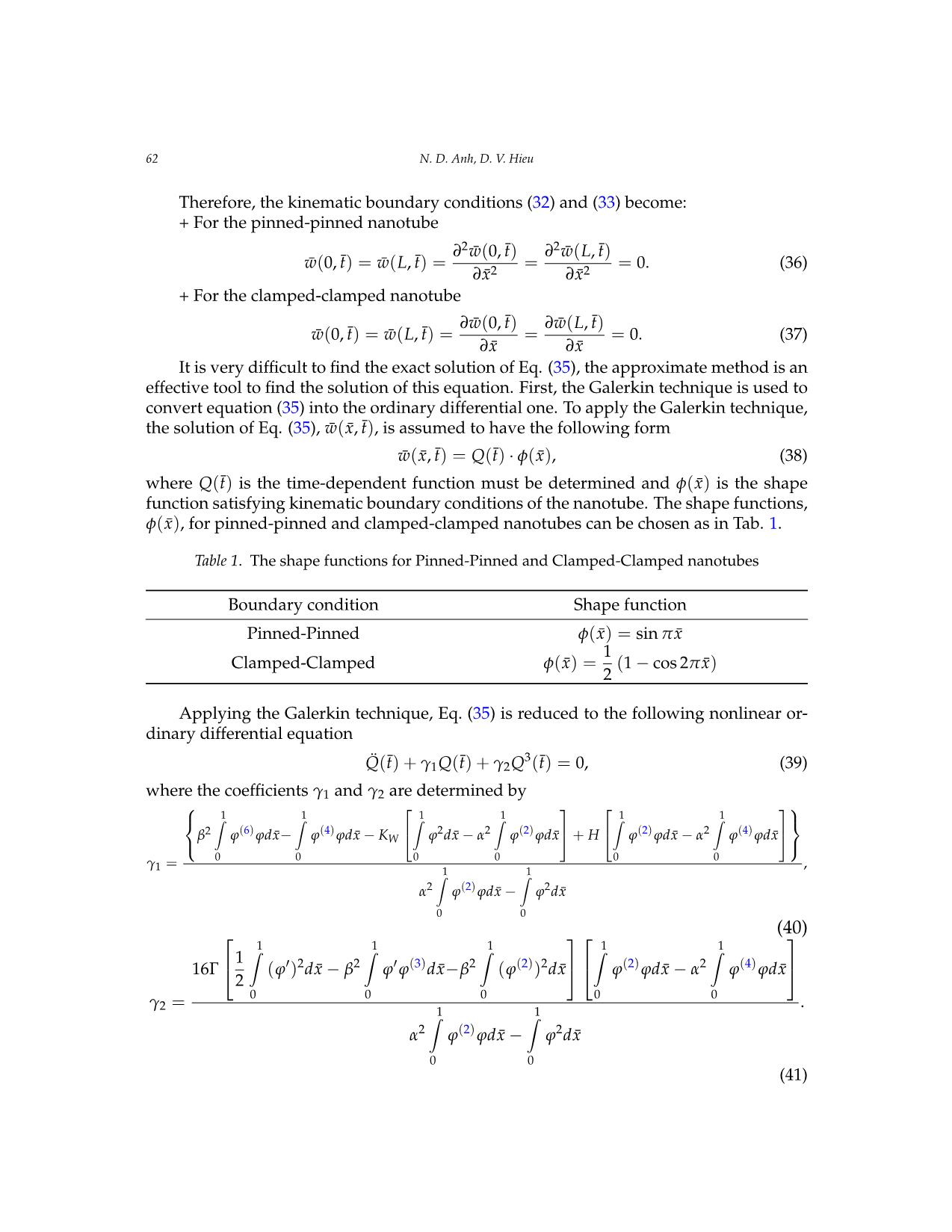
Trang 8
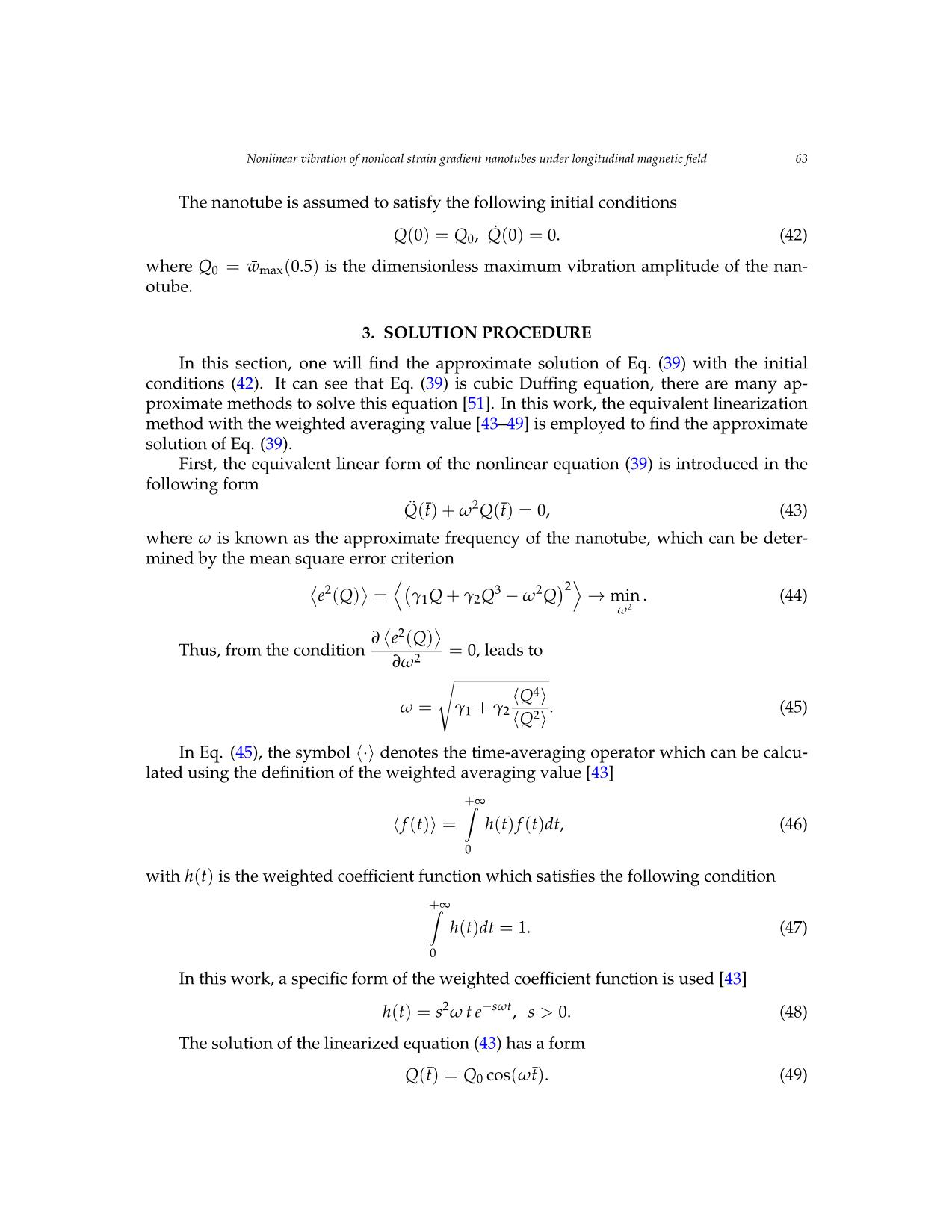
Trang 9
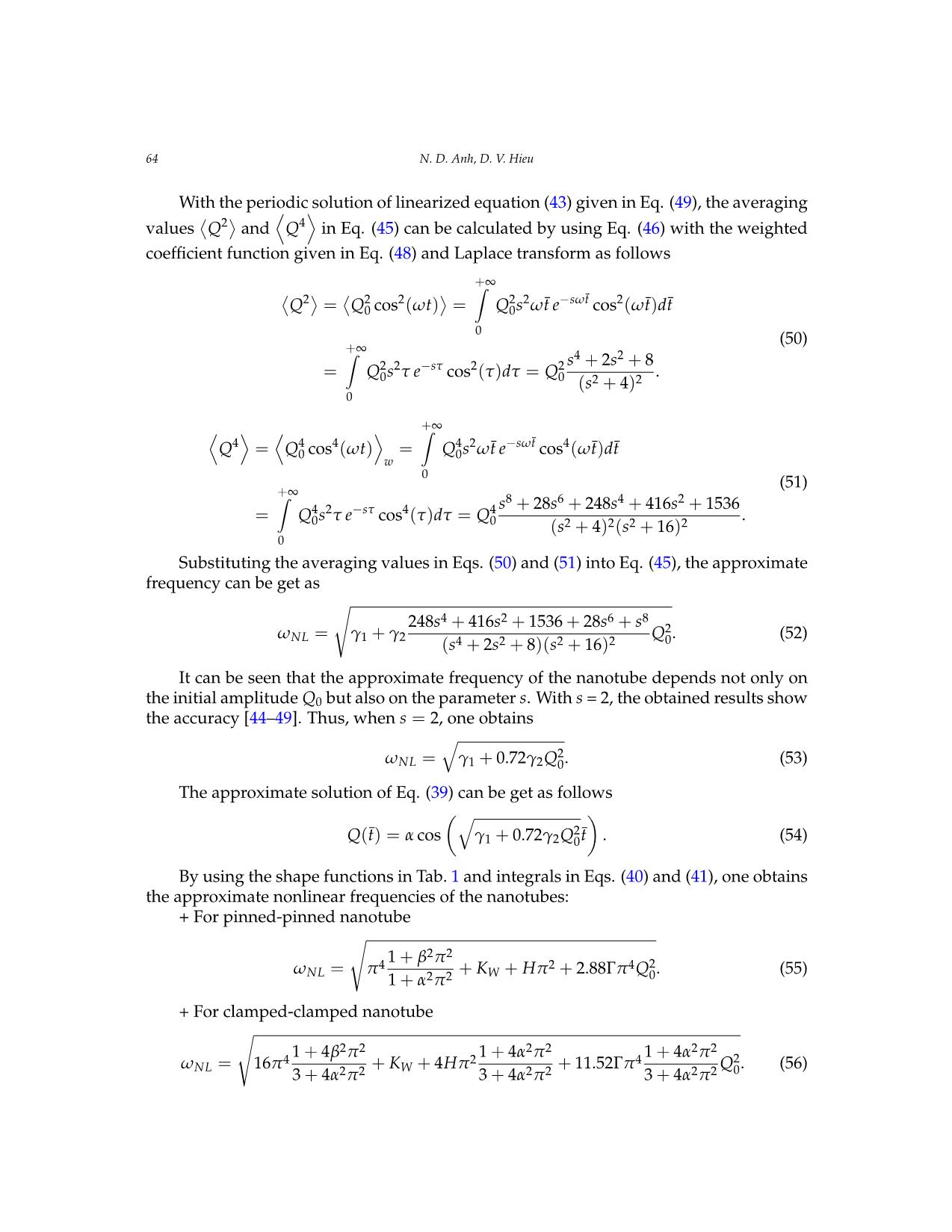
Trang 10
Tải về để xem bản đầy đủ
Tóm tắt nội dung tài liệu: Nonlinear vibration of nonlocal strain gradient nanotubes under longitudinal magnetic field
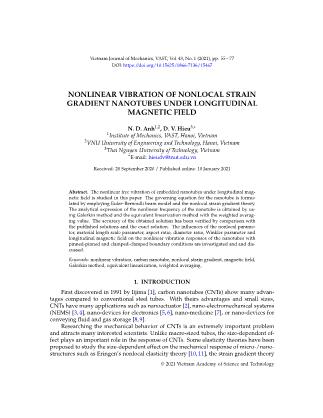
Vietnam Journal of Mechanics, VAST, Vol.43, No. 1 (2021), pp. 55 – 77 DOI: https://doi.org/10.15625/0866-7136/15467 NONLINEAR VIBRATION OF NONLOCAL STRAIN GRADIENT NANOTUBES UNDER LONGITUDINAL MAGNETIC FIELD N. D. Anh1,2, D. V. Hieu3,∗ 1Institute of Mechanics, VAST, Hanoi, Vietnam 2VNU University of Engineering and Technology, Hanoi, Vietnam 3Thai Nguyen University of Technology, Vietnam ∗E-mail: hieudv@tnut.edu.vn Received: 20 September 2020 / Published online: 10 January 2021 Abstract. The nonlinear free vibration of embedded nanotubes under longitudinal mag- netic field is studied in this paper. The governing equation for the nanotube is formu- lated by employing Euler–Bernoulli beam model and the nonlocal strain gradient theory. The analytical expression of the nonlinear frequency of the nanotube is obtained by us- ing Galerkin method and the equivalent linearization method with the weighted averag- ing value. The accuracy of the obtained solution has been verified by comparison with the published solutions and the exact solution. The influences of the nonlocal parame- ter, material length scale parameter, aspect ratio, diameter ratio, Winkler parameter and longitudinal magnetic field on the nonlinear vibration responses of the nanotubes with pinned-pinned and clamped-clamped boundary conditions are investigated and and dis- cussed. Keywords: nonlinear vibration, carbon nanotube, nonlocal strain gradient, magnetic field, Galerkin method, equivalent linearization, weighted averaging. 1. INTRODUCTION First discovered in 1991 by Iijima [1], carbon nanotubes (CNTs) show many advan- tages compared to conventional steel tubes. With theirs advantages and small sizes, CNTs have many applications such as nanoactuator [2], nano-electromechanical systems (NEMS) [3,4], nano-devices for electronics [5,6], nano-medicine [7], or nano-devices for conveying fluid and gas storage [8,9]. Researching the mechanical behavior of CNTs is an extremely important problem and attracts many interested scientists. Unlike macro-sized tubes, the size-dependent ef- fect plays an important role in the response of CNTs. Some elasticity theories have been proposed to study the size-dependent effect on the mechanical response of micro-/nano- structures such as Eringen’s nonlocal elasticity theory [10, 11], the strain gradient theory © 2021 Vietnam Academy of Science and Technology 56 N. D. Anh, D. V. Hieu (SGT) [12, 13], and the modified couple stress theory (MCST) [14]. To date, many works related to the static and dynamic responses of CNTs have been published using these higher-order elasticity theories. Nonlinear free vibration responses of the single-walled carbon nanotubes (SWCNTs) were reported by Yang et al. [15] using the Timoshenko beam theory and Eringen’s nonlocal elasticity theory. The effects of nonlocal parameter, length and radius of the SWCNTs with different boundary conditions on the nonlinear free vibration behaviors of SWCNTs were examined in this work. Narendar et al. [16] studied the wave propagation problem in the SWCNTs under longitudinal magnetic field based on Eringen’s nonlocal elasticity theory and the Euler-Bernoulli beam theory. The wave method was employed by Zhang et al. [17] to analyze the nonlinear free vibration of the fluid-conveying SWCNTs based on Eringen’s nonlocal elasticity theory. Based on the Euler-Bernoulli beam theory and Eringen’s nonlocal elasticity theory, Wang and Li [18] investigated the nonlinear free vibration of the SWCNTs with the viscous damping effect. Zhen and Fang [19] used the Lindstedt–Poincare´ method to investigate the nonlinear vi- bration of the fluid-conveying SWCTNs under harmonic excitation. Nonlinear vibration of the embedded SWCNTs was reported by Valipour et al. [20] using Eringen’s nonlocal elasticity theory and the parameterized perturbation method. Goughari et al. [21] stud- ied effects of magnetic-fluid flow on the instability of the fluid-conveying SWCNTs under the magnetic field. Free vibration of the SWCNTs resting on the exponentially varying elastic foundation was examined by Chakraverty and Jena using Eringen’s nonlocal elas- ticity theory [2]. Based on the MCST and the Euler-Bernoulli beam theory, Wang [22] investigated the size-dependent vibration responses of the fluid-conveying microtubes. Flexural size-dependent vibrations of the microtubes conveying fluid was carried out by Wang et al. [23] utilizing the MCST. Based on the MCST, Tang et al. [24] developed a non- linear model to study the size-dependent vibration of the curved microtubes conveying fluid. Xia and Wang [25] studied vibration and stability behaviors of the microscale pipes conveying fluid based on Timoshenko beam theory and the MCST. Based on the second SGT, vibration and stability behaviors of the SWCNTs conveying fluid were presented by Ghazavi et al. [26]. In 2015, the nonlocal parameter and the material length sca ... lutions. thepinned accuracy and of the clamped-clamped obtained approximate boundary solutions.conditions. The comparison of the obtained approximate solutions with the exact ones and the published ones shows the accuracy of the obtained approximate solutions. Effects of the nonlocal parameter ea/L, the material length scale parameter l/L, the aspect ratio L/D, the diameter ratio d/D, the elastic foundation KW and the magnetic field H on the nonlinear vibration responses of the nanotubes are examined. It can be concluded that: - The nonlocal parameter leads to a decrease in the nonlinear frequencies of the nan- otubes; while the material length scale parameter, the aspect ratio, the diameter ratio, the elastic foundation and the magnetic field lead to an increase in the nonlinear frequencies of the nanotubes. - When l < ea, the frequency ratios of the nanotube increase as the nonlocal parame- ter ea/L increases. However, when l > ea, the frequency ratios of the nanotube decrease as the nonlocal parameter ea/L increases. The frequency ratios of the NSGT nanotubes are always smaller than the ones of the nonlocal nanotubes (c = l/ea = 0). When c < 1, the frequency ratios of the nanotubes increase as the nonlocal and length scale parame- ters increase; while c > 1, the frequency ratios of the nanotubes decrease as the nonlocal and length scale parameters increase. 74 N. D. Anh, D. V. Hieu - The diameter ratio, the elastic foundation and the magnetic field lead to a decrease in the frequency ratios of the nanotubes; while the aspect ratio leads to an increase in the frequency ratios of the nanotubes. ACKNOWLEDGMENT This work was supported by Vietnam National Foundation for Science and Technol- ogy Development (NAFOSTED) under grant number 107.02-2020.03. REFERENCES [1] S. Iijima. Helical microtubules of graphitic carbon. Nature, 354, (6348), (1991), pp. 56–58. https://doi.org/10.1038/354056a0. [2] S. Chakraverty and S. K. Jena. Free vibration of single walled carbon nanotube resting on exponentially varying elastic foundation. Curved and Layered Structures, 5, (1), (2018), pp. 260– 272. https://doi.org/10.1515/cls-2018-0019. [3] P. Poncharal, Z. L. Wang, D. Ugarte, and W. A. De Heer. Electrostatic deflections and elec- tromechanical resonances of carbon nanotubes. Science, 283, (5407), (1999), pp. 1513–1516. https://doi.org/10.1126/science.283.5407.1513. [4] J. A. Pelesko and D. H. Bernstein. Modeling MEMS and NEMS. FL: Chapman & Hall/CRC, Boca Raton, (2003). [5] K. Tsukagoshi, N. Yoneya, S. Uryu, Y. Aoyagi, A. Kanda, Y. Ootuka, and B. W. Alphenaar. Carbon nanotube devices for nanoelectronics. Physica B: Condensed Matter, 323, (1-4), (2002), pp. 107–114. https://doi.org/10.1016/s0921-4526(02)00993-6. [6] W. B. Choi, E. Bae, D. Kang, S. Chae, B.-h. Cheong, J.-h. Ko, E. Lee, and W. Park. Aligned carbon nanotubes for nanoelectronics. Nanotechnology, 15, (10), (2004). https://doi.org/10.1088/0957-4484/15/10/003. [7] M. Samadishadlou, M. Farshbaf, N. Annabi, T. Kavetskyy, R. Khalilov, S. Saghfi, A. Ak- barzadeh, and S. Mousavi. Magnetic carbon nanotubes: preparation, physical properties, and applications in biomedicine. Artificial Cells, Nanomedicine, and Biotechnology, 46, (7), (2018), pp. 1314–1330. https://doi.org/10.1080/21691401.2017.1389746. [8] Y. Gao and Y. Bando. Carbon nanothermometer containing gallium. Nature, 415, (6872), (2002), pp. 599–599. https://doi.org/10.1038/415599a. [9] G. Hummer, J. C. Rasaiah, and J. P. Noworyta. Water conduction through the hy- drophobic channel of a carbon nanotube. Nature, 414, (6860), (2001), pp. 188–190. https://doi.org/10.1038/35102535. [10] A. C. Eringen and D. G. B. Edelen. On nonlocal elasticity. International Journal of Engineering Science, 10, (3), (1972), pp. 233–248. https://doi.org/10.1016/0020-7225(72)90039-0. [11] A. C. Eringen. On differential equations of nonlocal elasticity and solutions of screw dislocation and surface waves. Journal of Applied Physics, 54, (9), (1983), pp. 4703–4710. https://doi.org/10.1063/1.332803. [12] R. D. Mindlin. Micro-structure in linear elasticity. Archive for Rational Mechanics and Analysis, 16, (1), (1964), pp. 51–78. https://doi.org/10.1007/bf00248490. [13] R. D. Mindlin. Second gradient of strain and surface-tension in linear elasticity. Interna- tional Journal of Solids and Structures, 1, (4), (1965), pp. 417–438. https://doi.org/10.1016/0020- 7683(65)90006-5. Nonlinear vibration of nonlocal strain gradient nanotubes under longitudinal magnetic field 75 [14] F. A. C. M. Yang, A. C. M. Chong, D. C. C. Lam, and P. Tong. Couple stress based strain gradi- ent theory for elasticity. International Journal of Solids and Structures, 39, (10), (2002), pp. 2731– 2743. https://doi.org/10.1016/s0020-7683(02)00152-x. [15] J. Yang, L. L. Ke, and S. Kitipornchai. Nonlinear free vibration of single-walled carbon nanotubes using nonlocal Timoshenko beam theory. Physica E: Low-dimensional Systems and Nanostructures, 42, (5), (2010), pp. 1727–1735. https://doi.org/10.1016/j.physe.2010.01.035. [16] S. Narendar, S. S. Gupta, and S. Gopalakrishnan. Wave propagation in single- walled carbon nanotube under longitudinal magnetic field using nonlocal Euler– Bernoulli beam theory. Applied Mathematical Modelling, 36, (9), (2012), pp. 4529–4538. https://doi.org/10.1016/j.apm.2011.11.073. [17] Z. Zhang, Y. Liu, and B. Li. Free vibration analysis of fluid-conveying carbon nan- otube via wave method. Acta Mechanica Solida Sinica, 27, (6), (2014), pp. 626–634. https://doi.org/10.1016/s0894-9166(15)60007-6. [18] Y.-Z. Wang and F.-M. Li. Nonlinear free vibration of nanotube with small scale effects embedded in viscous matrix. Mechanics Research Communications, 60, (2014), pp. 45–51. https://doi.org/10.1016/j.mechrescom.2014.06.002. [19] Y.-X. Zhen and B. Fang. Nonlinear vibration of fluid-conveying single-walled carbon nan- otubes under harmonic excitation. International Journal of Non-Linear Mechanics, 76, (2015), pp. 48–55. https://doi.org/10.1016/j.ijnonlinmec.2015.05.005. [20] P. Valipour, S. E. Ghasemi, M. R. Khosravani, and D. D. Ganji. Theoretical analysis on nonlin- ear vibration of fluid flow in single-walled carbon nanotube. Journal of Theoretical and Applied Physics, 10, (3), (2016), pp. 211–218. https://doi.org/10.1007/s40094-016-0217-9. [21] M. Sadeghi-Goughari, S. Jeon, and H.-J. Kwon. Effects of magnetic-fluid flow on structural instability of a carbon nanotube conveying nanoflow under a lon- gitudinal magnetic field. Physics Letters A, 381, (35), (2017), pp. 2898–2905. https://doi.org/10.1016/j.physleta.2017.06.054. [22] L. Wang. Size-dependent vibration characteristics of fluid-conveying mi- crotubes. Journal of Fluids and Structures, 26, (4), (2010), pp. 675–684. https://doi.org/10.1016/j.jfluidstructs.2010.02.005. [23] L. Wang, H. T. Liu, Q. Ni, and Y. Wu. Flexural vibrations of microscale pipes conveying fluid by considering the size effects of micro-flow and micro-structure. International Journal of Engineering Science, 71, (2013), pp. 92–101. https://doi.org/10.1016/j.ijengsci.2013.06.006. [24] M. Tang, Q. Ni, L. Wang, Y. Luo, and Y. Wang. Nonlinear modeling and size- dependent vibration analysis of curved microtubes conveying fluid based on modified couple stress theory. International Journal of Engineering Science, 84, (2014), pp. 1–10. https://doi.org/10.1016/j.ijengsci.2014.06.007. [25] W. Xia and L. Wang. Microfluid-induced vibration and stability of structures modeled as mi- croscale pipes conveying fluid based on non-classical Timoshenko beam theory. Microfluidics and Nanofluidics, 9, (4-5), (2010), pp. 955–962. https://doi.org/10.1007/s10404-010-0618-z. [26] M. R. Ghazavi, H. Molki, and A. A. Beigloo. Nonlinear analysis of the micro/nanotube conveying fluid based on second strain gradient theory. Applied Mathematical Modelling, 60, (2018), pp. 77–93. https://doi.org/10.1016/j.apm.2018.03.013. [27] C. W. Lim, G. Zhang, and J. N. Reddy. A higher-order nonlocal elasticity and strain gradient theory and its applications in wave propagation. Journal of the Mechanics and Physics of Solids, 78, (2015), pp. 298–313. https://doi.org/10.1016/j.jmps.2015.02.001. 76 N. D. Anh, D. V. Hieu [28] M. S¸ims¸ek. Nonlinear free vibration of a functionally graded nanobeam using nonlocal strain gradient theory and a novel Hamiltonian approach. International Journal of Engineering Sci- ence, 105, (2016), pp. 12–27. https://doi.org/10.1016/j.ijengsci.2016.04.013. [29] M. N. M. Allam and A. F. Radwan. Nonlocal strain gradient theory for bend- ing, buckling, and vibration of viscoelastic functionally graded curved nanobeam em- bedded in an elastic medium. Advances in Mechanical Engineering, 11, (4), (2019). https://doi.org/10.1177/1687814019837067. [30] S. Esfahani, S. E. Khadem, and A. E. Mamaghani. Nonlinear vibration analysis of an electrostatic functionally graded nano-resonator with surface effects based on nonlocal strain gradient theory. International Journal of Mechanical Sciences, 151, (2019), pp. 508–522. https://doi.org/10.1016/j.ijmecsci.2018.11.030. [31] V.-H. Dang, D.-A. Nguyen, M.-Q. Le, and T.-H. Duong. Nonlinear vibration of nanobeams under electrostatic force based on the nonlocal strain gradient theory. International Journal of Mechanics and Materials in Design, (2019), pp. 1–20. https://doi.org/10.1007/s10999-019- 09468-8. [32] R. Bahaadini, A. R. Saidi, and M. Hosseini. Flow-induced vibration and stability analysis of carbon nanotubes based on the nonlocal strain gradient Timoshenko beam theory. Journal of Vibration and Control, 25, (1), (2019), pp. 203–218. https://doi.org/10.1177/1077546318774242. [33] M. Malikan, V. B. Nguyen, and F. Tornabene. Damped forced vibration analysis of single- walled carbon nanotubes resting on viscoelastic foundation in thermal environment using nonlocal strain gradient theory. Engineering Science and Technology, 21, (4), (2018), pp. 778– 786. https://doi.org/10.1016/j.jestch.2018.06.001. [34] G.-L. She, Y.-R. Ren, F.-G. Yuan, and W.-S. Xiao. On vibrations of porous nanotubes. International Journal of Engineering Science, 125, (2018), pp. 23–35. https://doi.org/10.1016/j.ijengsci.2017.12.009. [35] M. Atashafrooz, R. Bahaadini, and H. R. Sheibani. Nonlocal, strain gradient and surface effects on vibration and instability of nanotubes conveying nanoflow. Mechanics of Advanced Materials and Structures, 27, (7), (2020), pp. 586–598. https://doi.org/10.1080/15376494.2018.1487611. [36] L. Li, Y. Hu, X. Li, and L. Ling. Size-dependent effects on critical flow velocity of fluid- conveying microtubes via nonlocal strain gradient theory. Microfluidics and Nanofluidics, 20, (5), (2016), p. 76. https://doi.org/10.1007/s10404-016-1739-9. [37] M. H. Ghayesh and A. Farajpour. Nonlinear mechanics of nanoscale tubes via nonlocal strain gradient theory. International Journal of Engineering Science, 129, (2018), pp. 84–95. https://doi.org/10.1016/j.ijengsci.2018.04.003. [38] M. H. Ghayesh and A. Farajpour. Nonlinear coupled mechanics of nanotubes incorporating both nonlocal and strain gradient effects. Mechanics of Advanced Materials and Structures, 27, (5), (2020), pp. 373–382. https://doi.org/10.1080/15376494.2018.1473537. [39] A. Azrar, M. Ben Said, L. Azrar, and A. A. Aljinaidi. Dynamic analysis of Car- bon NanoTubes conveying fluid with uncertain parameters and random excita- tion. Mechanics of Advanced Materials and Structures, 26, (10), (2019), pp. 898–913. https://doi.org/10.1080/15376494.2018.1430272. [40] L. Li, Y. Hu, and L. Ling. Wave propagation in viscoelastic single-walled carbon nan- otubes with surface effect under magnetic field based on nonlocal strain gradient the- ory. Physica E: Low-dimensional Systems and Nanostructures, 75, (2016), pp. 118–124. https://doi.org/10.1016/j.physe.2015.09.028. Nonlinear vibration of nonlocal strain gradient nanotubes under longitudinal magnetic field 77 [41] L. Li and Y. Hu. Wave propagation in fluid-conveying viscoelastic carbon nanotubes based on nonlocal strain gradient theory. Computational Materials Science, 112, (2016), pp. 282–288. https://doi.org/10.1016/j.commatsci.2015.10.044. [42] Y. Zhen and L. Zhou. Wave propagation in fluid-conveying viscoelastic car- bon nanotubes under longitudinal magnetic field with thermal and surface ef- fect via nonlocal strain gradient theory. Modern Physics Letters B, 31, (08), (2017). https://doi.org/10.1142/s0217984917500695. [43] N. D. Anh. Dual approach to averaged values of functions: A form for weighting coeffi- cient. Vietnam Journal of Mechanics, 37, (2), (2015), pp. 145–150. https://doi.org/10.15625/0866- 7136/37/2/6206. [44] N. D. Anh, N. Q. Hai, and D. V. Hieu. The equivalent linearization method with a weighted averaging for analyzing of nonlinear vibrating systems. Latin American Journal of Solids and Structures, 14, (9), (2017), pp. 1723–1740. https://doi.org/10.1590/1679-78253488. [45] D. V. Hieu. A new approximate solution for a generalized nonlinear oscilla- tor. International Journal of Applied and Computational Mathematics, 5, (5), (2019). https://doi.org/10.1007/s40819-019-0709-9. [46] D. V. Hieu and N. Q. Hai. Analyzing of nonlinear generalized duffing oscillators using the equivalent linearization method with a weighted averaging. Asian Research Journal of Mathe- matics, (2018), pp. 1–14. https://doi.org/10.9734/arjom/2018/40684. [47] V. Hieu-Dang. An approximate solution for a nonlinear Duffing– Harmonic oscillator. Asian Research Journal of Mathematics, (2019), pp. 1–14. https://doi.org/10.9734/arjom/2019/v15i430154. [48] D. V. Hieu, N. Q. Hai, and D. T. Hung. The equivalent linearization method with a weighted averaging for solving undamped nonlinear oscillators. Journal of Applied Mathematics, 2018, (2018). https://doi.org/10.1155/2018/7487851. [49] D. V. Hieu and N. Q. Hai. Free vibration analysis of quintic nonlinear beams using equiv- alent linearization method with a weighted averaging. Journal of Applied and Computational Mechanics, 5, (1), (2019), pp. 46–57. https://doi.org/10.22055/JACM.2018.24919.1217. [50] S. S. Rao. Vibration of continuous systems. John Wiley & Sons, Inc., (2007). [51] M. Bayat, I. Pakar, and G. Domairry. Recent developments of some asymptotic meth- ods and their applications for nonlinear vibration equations in engineering problems: A review. Latin American Journal of Solids and Structures, 9, (2), (2012), pp. 1–93. https://doi.org/10.1590/s1679-78252012000200003. [52] T.-P. Chang. Nonlinear free vibration analysis of nanobeams under magnetic field based on nonlocal elasticity theory. Journal of Vibroengineering, 18, (3), (2016), pp. 1912–1919. https://doi.org/10.21595/jve.2015.16751.
File đính kèm:
 nonlinear_vibration_of_nonlocal_strain_gradient_nanotubes_un.pdf
nonlinear_vibration_of_nonlocal_strain_gradient_nanotubes_un.pdf

